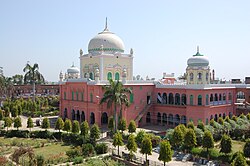Ilyas Kandhlawi
Muhammad Ilyas Kandhlawi | |
|---|---|
| 1st Amir of Tablighi Jamaat | |
| Succeeded by | Muhammad Yusuf Kandhlawi |
| Title | Hazrat Ji |
| Personal | |
| Born | Akhtar Ilyas 1885 (1302 Hijri year) |
| Died | 13 July 1944 (1363 Hijri year) Nizamuddin, Delhi |
| Nationality | Indian |
| Denomination | Sunni |
| Jurisprudence | Hanafi |
| Movement | Deobandi |
| Main interest(s) | Da'wah |
| Notable work(s) | Tablighi Jamaat |
| Alma mater | Darul Uloom Deoband |
| Tariqa | Chishti-Nizami |
| Occupation | Da'i |
| Senior posting | |
| Disciple of | Rashid Ahmad Gangohi Muhammad Ismail Kandhlawi Khalil Ahmad Saharanpuri Muhammad Yahya Kandhlawi |
Influenced by
| |
Influenced
| |
| Part of a series on the |
| Deobandi movement |
|---|
 |
| Ideology and influences |
| Founders and key figures |
|
| Notable institutions |
| Centres (markaz) of Tablighi Jamaat |
| Associated organizations |
Muḥammad Ilyās ibn Muḥammad Ismā‘īl Kāndhlawī Dihlawī was an Indian Islamic scholar and Sufi who revived the Tablighi Jamaat Islamic revivalist movement. Tablighi Jamaat was another group started for the reformation of Muslims, which was begun in 1925 in Mewat province by Muhammad Ilyas Kandhlawi."[1]
Name and lineage
He was Muhammad Ilyas ibn Muhammad Ismail, Kandhlawi (of Kandhla) by birth and origin, then Dihlawi (of Delhi).
Early life and education
Muhammad Ilyas was born in 1303 AH (1885/1886) in the village of Kandhla, Muzaffarnagar district, North-West Provinces, British India (in present-day Shamli district, Uttar Pradesh, India). His year of birth can be computed by the tarikhi (chronogrammatic) name "Akhtar Ilyas" (اختر الیاس) using abjad numerals.[2]
He was the son of Muhammad Ismail and his second wife, Safiyah.[2]
In a local maktab (school), he memorized one and a quarter ajza' of the Qur'an, and he completed memorizing the Qur'an under his father's supervision in Nizamuddin area, Delhi. Thereafter, he studied the elementary books of Arabic and Persian language mostly under his father.[2]
Later on, he lived with and studied under Rashid Ahmad Gangohi. In 1905, Rashid Ahmad Gangohi died, when Muhammad Ilyas was 20. In 1908, Muhammad Ilyas enrolled in Darul Uloom Deoband.
Foundation of Tablighi Jamaat
In the early 1920s, he prepared a team of young madrasah graduates from Deoband and Saharanpur and sent them to Mewat to establish a network of mosques and Islamic schools movement. He once said that if he had to attribute a name to his movement, it would have been Tehreek-e-Imaan ('Imaan/Faith movement'). The people of South Asia started calling the devotees Tableeghi and this name eventually became popular among the common people.
A summary of viewpoints on Tablighi Jamaat
- "Indian reform movement founded by Mawlana Muhammad Ilyas in 1927 in Delhi. Popular with villagers and peasants. Called for reform of personal religious practices and defense of Islam and Muslim minority populations. Focused on religious, rather than political, aspects of Islam. Spread throughout the Muslim world from 1950 on."[3]
- "The Tableeghi Jamaat was set up under the British Rule in India. After closely watching the Jamaat for some time, the British realised that here was exactly what they were looking for, a movement that totally absorbed the energy of its members and yet did not threaten British domination in any way as the doctrine of Jihad was totally absent in this movement. They saw that instead of the Jamaat's directing their energies outwardly towards their legitimate Kaafir enemies, was now directed inwardly towards the rest of the Muslims. Therefore, it was a group that was allowed to flourish."[4]
Sources
- Nadwi, Abu'l-Hasan `Ali. Life and Mission of Maulana Muhammad Ilyas.
- "Profile of Maulana Mohammad Ilyas Kandhlawi". Madrasa Islamia Arabia Khadimul-Uloom Baghonwali and Bajheri. Retrieved 3 May 2017.
- Yoginder Sikand (17 April 2010). "The Tablighi Jamaat in Mewat -- Part 2". TwoCircles.net. Retrieved 3 May 2017.
References
- ^ Muhammad Ilyas Kandhlawi on Dawn newspaper, Published 3 December 2009, Retrieved 3 May 2017
- ^ a b c Sayyid Abul-Ḥasan ‘Alī Nadwī (n.d.) [First published c. 1947]. حضرت مولانا محمد الیاس اور ان کی دینی دعوت / Ḥaẓrat Maulānā Muḥammad Ilyās aur un kī dīnī da‘wat (in Urdu). Rā’ewind [Raiwind]: Maktabah Maḥmūdīyah.
- ^ A summary viewpoint on Tablighi Jamaat on Oxford Islamic Studies Online website, Retrieved 3 May 2017
- ^ Tableeghi Jamaat Exposed on Islamic Academy website, Retrieved 3 May 2017
